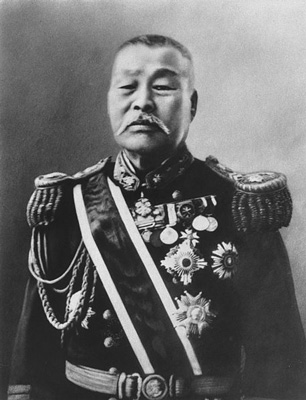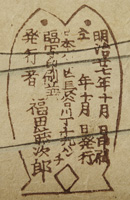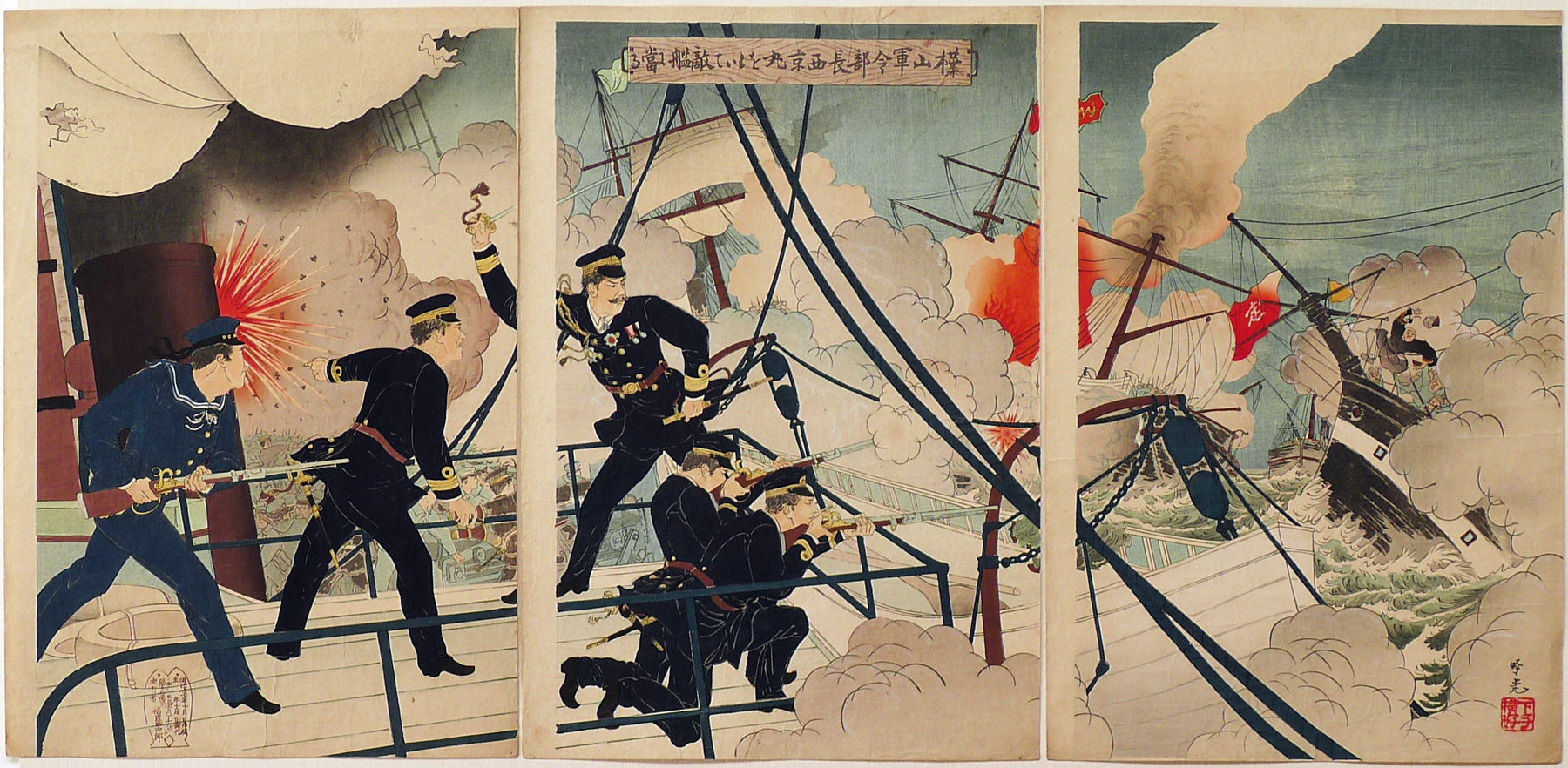About This Print
Depicting one of the engagements in the September 17, 1894 Battle of the Yellow Sea (also referred to as the Battle of the Yalu River), we see Rear Admiral and chief of the navy general staff, Kabayama Sukenori, on the cruiser Saikyō-Maru directing gun fire at attacking Chinese ships.Source: The Sino-Japanese War, Nathan Chaikin, self-published, 1983, p. 78.
The Saikyō-Maru(formerly the Yūsen Kaishō) had beendirected to keep out of danger as much as possible, but seeing the Yung-wei trying to escape, she had goneoff in pursuit: she was then herself attacked by the Chinese enshore [sic] squadron. In the meantime the detached Chinese vessels and sometorpedo-boats came up on the other side, and the Saikyō-Maru was between two fires. One of the torpedo-boats crossed her bow and discharged two torpedoes,which luckily missed, as she was going full speed at the time; one of thetorpedoes is said to have passed right under her coming up on the other side. PS- It must be underlined that Kabayama was really acting asan observer and was not supposed to take action, but was forced to do so. |
Battle of the Yellow Sea
Source: Japan at the Dawn of the Modern Age – WoodblockPrints from the Meiji Era, Louise E. Virgin, Donald Keene, et. al.,MFA Publications, 2001, p.72."The Battle of the Yellow Sea was...important to the Japanese because the West greatly respected naval might. As the first naval battle in history between steam-powered boats, it was widely covered in international magazines and newspapers - some paid by the Japanese government to favorably cover the war. Many print artists were also inspired (or commissioned) to produce sensational, panoramic scenes of the struggle between the Japanese Combined Fleet of twelve warships led by the Matsushima, and the Chinese Peiyang, or Northern Fleet, led by the Tingyuen."

(樺山資紀, 1837 – 1922)
For another print related to this particular battle see Naval Officers Discussing the Battle Strategy
for the Invasion of China.
A Designed Reused
Publishers occasionally re-purposed designs for new occasions. In this case, the 1894 print commemorating the actions of Rear Admiral Kabayama during the Battle of the Yellow Sea was reused to commemorate the 1904 actions of Japanese soldiers and sailors during the Naval Battle at Port Arthur during the Russo-Japanese War of 1904 - 1905. For another example of this practice see the print Japanese Forces Occupying Yizhou. Russian Soldiers Fleeing to the North Bank of the Yalu River.
On the rightpanel of the bottom 1904 print slight changes have been made to turn the Chinese warships intoRussian vessels. The signature and seal of the artist Adachi Ginkō, who created the 1894 print, has been removed and replaced with the signature and seal of an unknown artist read Sengai. An English title "The Japanese blockaders fighting with great bravery at Port Arthur" has been added in scripted form to the right panel and the original title block on the center panel has been replaced. Sengai, Japanese, active 1900–1910 Fukuda Hatsujiro (publisher), Japanese The Japanese Blockaders Fighting with Great Bravery at Port Arthur, 1904 Color woodcut triptych 35.8 x 72 cm (image); 37.3 x 73.1 cm (sheet); 35.8 x 72 cm Achenbach Foundation for Graphic Arts 1963.30.5722abc |
Print Details
| IHL Catalog | #834 |
| Title or Description | Kabayama, the Head of the Naval Commanding Staff, on board Seikyōmaru, Attacks Enemy Ship Kabayama gunreibuchô Seikyômaru o motte tekikan ni ataru 樺山軍令部長西京丸を以って敵艦に當る |
| Artist | Adachi Ginkō (active 1874 – 1897) |
| Signature |  |
| Seal | Heta no yokozuki (see above) |
| Publication Date | October 1894 (Meiji 27) |
| Publisher |  |
| Carver | |
| Printer | |
| Impression | excellent |
| Colors | excellent |
| Condition | good - three separate, full-size, unbacked panels; minor wrinkling throughout; slight toning throughout |
| Genre | ukiyo-e - senso-e (Sino-Japanese War) |
| Miscellaneous | |
| Format | vertical oban triptych |
| H x W Paper | 14 3/8 x 28 1/2 in. (36.5 x 72.4 cm) |
| H x W Image | |
| Literature | The Sino-Japanese War, Nathan Chaikin, self-published, 1983, p. 78, pl. 44 |
| Collections This Print | Museum of Fine Arts, Boston 2000.380.14a-c, 2000.376a-c; Leger Museum, Delft, Netherlands 00121422 |



